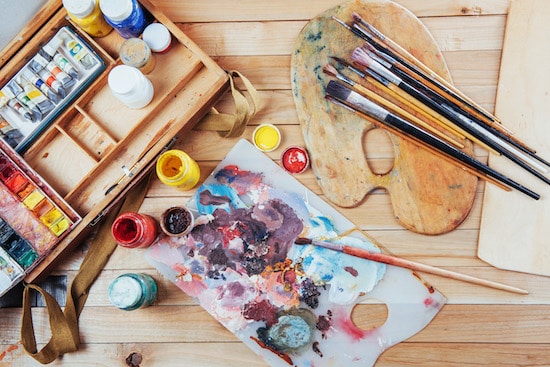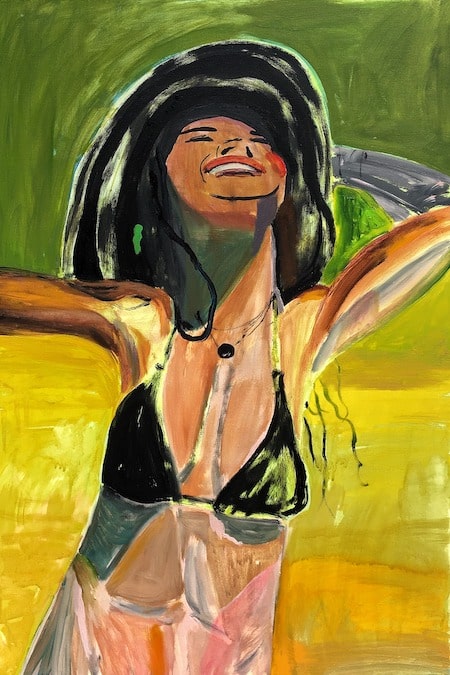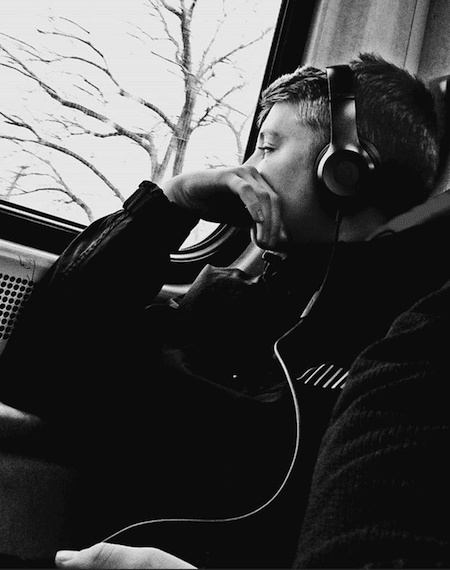Art has always been used to heal and work through complex emotions. While typically not a total replacement, art therapy can often be used as a supplement to talk therapy, allowing for exploration and self-expression.
We’ve all felt crazy and hectic moments in our lives: work feels like it’s piling up, obligations to friends and family are heavy, stress is high, and spirits are low. A lot of my time in therapy has been spent identifying moments to relax during these periods. We often look at things like eating a good meal, taking a long shower, or binging a show as a preferred method of self-care. But what if we put ourselves into action, into art?
Licensed art therapists can guide individuals through the process of art-making to draw on emotions and thoughts that cannot be thoroughly talked about.
The American Art Therapy Association describes art therapy as an integrative mental health and human services profession that enriches the lives of individuals, families, and communities through active art-making and the creative process within a psychotherapeutic relationship.
Keep reading to learn about the five types of art therapy and where you can start practicing art as a therapeutic tool.
The Five Types of Art Therapy
1. VISUAL ART
Art often helps individuals put imagery to emotions or ideas they can’t express through words. During times of intense emotion, art creation has been studied as a way to contextualize situations, most often illness.
In various studies involving women diagnosed with heart disease and breast cancer, patients used art creation to understand their illnesses and describe their new emotions. Through these studies, researchers identified four main takeaways as the significant ways art helped: as a way to focus on positive life experiences, as a way to enhance their self-worth, as a way to retain their social identity, and as a way to express their feelings symbolically.
To incorporate visual arts into your self-care, the options to choose from are as comprehensive as the discipline. With a simple pen and paper, spend some time thinking about how you feel and drawing what that emotion looks like. Next, draw your emotion’s movement or how it changes in the space of the paper, considering how your feelings change over time.

Studies show creating art can allow people to process complex emotions and difficult situations.
Taking note of the study with heart disease patients, try drawing your body or a similar form and attaching your feelings to your body. You can do this through different textures or colors.
To incorporate painting, try allowing fluid brushstrokes to guide your creation. Pick paint or colors based on your thoughts and paint without a goal — art therapy is all about the process. You can use clay to create sculptures, allowing anxiety, intense emotions, or other thoughts to take a physical form. In the end, the sculpture can be kept as a reminder of the process or feeling or recycled into your next piece.
2. MOVEMENT

John Paul Kiesling, “Oh Girl, You in Love!” (2022). You can incorporate movement and dance into your self-care routine by finding a local class — or simply putting your headphones on!
Movement, or dance, therapy grew in popularity in the 1940s, connecting the mind and body directly through motion. Movement therapy focuses on nonverbal expression through physical movement while allowing for other health benefits.
Like visual art therapy, movement therapy appears in a variety of ways. While dance is one aspect of movement therapy, styles of dance vary. Often, dance therapy presents itself along the lines of modern dance, which allows for fluid motion and instincts. Other dance styles, such as ballet, can create structure. The type of dance you choose can reflect what you are looking for.
Tai chi has also been used as a method of movement therapy. Derived from martial arts, the slower movements of tai chi allow breathing meditation and building balance. Individuals practicing tai chi expressed better over a range of motion and higher-rated body image.
Similarly, yoga focuses on connecting with one’s body and feeling present. Yoga therapists can address different mental health needs through one-on-one sessions. There is a
mind-body focus in yoga that aids in developing both mental and physical awareness. This focus helps with mind-body integration and improves mindfulness.
To incorporate movement or dance into self-care, look into local dance or yoga studios. Many locations will have a variety of classes geared towards adults, and individual teachers or instructors may offer one-on-one time. These classes can be low commitment, as you can pay per class or even find donation-based community models. Try out a few lessons to find what type of movement you are most suited for, what styles of yoga or dance you are drawn to, and which instructors and classmates you click with.
If you are interested in learning more about movement therapy or finding a specialized movement therapist, the
American Dance Therapy Association provides avenues of communication among dance/movement therapists and those working in related fields and increases public awareness of dance/movement therapy.
3. MUSIC
Music is accessible to most people and is possibly one of the most researched forms of art therapy. Thanks to its soothing qualities,
music has been shown to decrease anxiety and restore emotional balance.
Music has been studied as an effective way to reduce stress, anxiety, and depression among cancer patients and people recovering from intimate partner violence. During World War I and II, musicians were hired to perform for soldiers and those recovering from injuries. Staff at the hospitals saw patients’ symptoms abate when music was actively present while they recovered.
According to the
American Music Therapy Association, music therapists assess emotional well-being, physical health, social functioning, communication abilities, and cognitive skills through musical responses while designing music sessions for individuals and groups based on client needs using music improvisation, receptive music listening, songwriting, lyric discussion, music and imagery, music performance, and learning through music. Therapists will also participate in interdisciplinary treatment planning, ongoing evaluation, and follow-up. During music therapy, individuals may actively compose and create their music, or they may be led in directed music activities by a therapist.

Scott Ballweg, “Lost in My Music on the Way to NYC” (2019) captures the feeling of getting lost in a song.
We can see the effects of music in our everyday lives and how music can calm, energize or motivate. In waiting rooms and hospitals, music often creates a calming effect due to the emotional space created. However, in shops and retail stores, the music is much more likely to be high energy, almost dance-like. This creates an uplifting environment not only for the shopper but also for the customer service employees.
The use of music in your everyday life can be easy. While working, many people have created music playlists that are calming and focusing, allowing for little distraction. This can benefit people who tend to have issues with concentrating while working. If you have a complicated or stressful commute, such as in rush hours or on public transit, songs that are still light can be helpful to relieve stress. During the morning, you may prefer more energizing songs to start, but more calm songs on the way home in the evening.
When listening to music, take note of how it affects your mood. Do you prefer soothing instrumental soundscapes or high-energy beats? What kind of music motivates you to take on a challenge or launch a productive streak? What styles do you turn to for emotional release? Consider creating playlists for different moods and cueing them up when you experience anxiety or are looking to wind down for sleep or focus.
4. DRAMA
Drama therapy uses aspects of drama and theater performance to make meaningful changes. A therapist focuses on an individual’s needs and then considers approaches that might best meet those needs. Drama therapy can take many forms depending on individual and group needs, skill and ability levels, interests, and therapeutic goals.
Processes and techniques for drama therapy may include improvisations, theater games, or storytelling. Many drama therapists use text, performance, or ritual to enrich the creative process. Individuals are often encouraged to play out the parts of themselves that they typically would in real-life situations.
Skill level matters very little in drama therapy, as the goal is not to improve any skills to a professional level but to work through emotional and situational barriers.
Like dance, local community theaters may offer adult classes in drama techniques, often in one-off or weekly sessions. These are usually in groups, so these classes are an excellent way to connect with others.
5. WRITING
Expressive writing is often encouraged by those in therapy as a way to communicate emotions to oneself. Writing can take many forms, such as using both prose and poetry. Expressive writing is also excellent for individuals who are recovering or experiencing psychological and physiological pain. There has been
improvement in well-being from writing in patients and relief from fatigue.
Typically, therapists will assign prompts to individuals coping with pain or trauma, encouraging them to write any and all thoughts on their emotions or experiences. This can result in personal journal entries and transform them into poetic works.
Paired with writing may also be suggested readings for individuals. Therapists will recommend passages, articles, or books related to someone’s needs and may help them understand or process emotions.
The professional association for poetry therapy is the
National Association for Poetry Therapy. They describe poetry therapy as using language, symbols, and stories in therapeutic, educational, growth, and community-building capacities. Poetry relies upon poems, stories, song lyrics, imagery, and metaphor to facilitate personal growth, healing, and greater self-awareness.

A journaling practice can take a structured form or be more free-flowing.
To bring writing into your self-care, there are many journals with thoughtful prompts and daily prompts to add daily writing structure. You can also look into prompts online for a more accessible resource.
However, prompts are not needed to begin writing. Daily journaling can be an unconscious effort, putting words down on paper about your current worries, anxieties, or emotions. This can be a more fluid practice of getting everyone currently on your mind written down. Over time, this practice can turn more creative, adapting new styles or structures to your free writing.
A quick search online also offers many book recommendations for further therapy exploration and various practices.
The creative process for all is limitless, and art often results in a more in-depth discovery of one’s emotions and problems. Therapists encourage individuals toward self-expression and create strategies that break up negative patterns.
Challenge yourself to include a new art style in your self-care. This can help you develop a new skill and process complex emotions through familiar activities. As you work towards self-improvement, you may discover a style of self-expression that allows you to be a more authentic version of yourself.
What type of art therapy would you like to try?